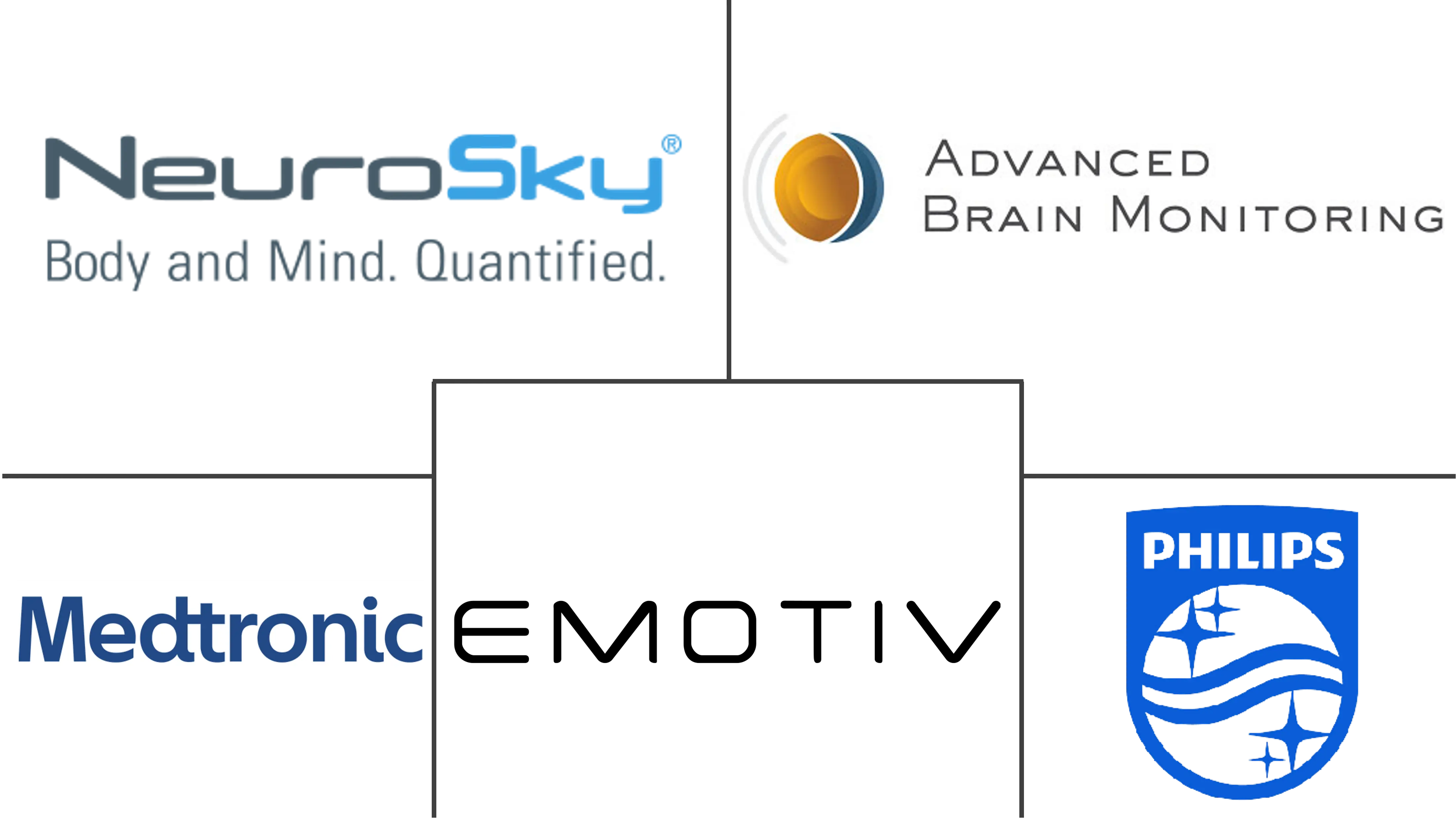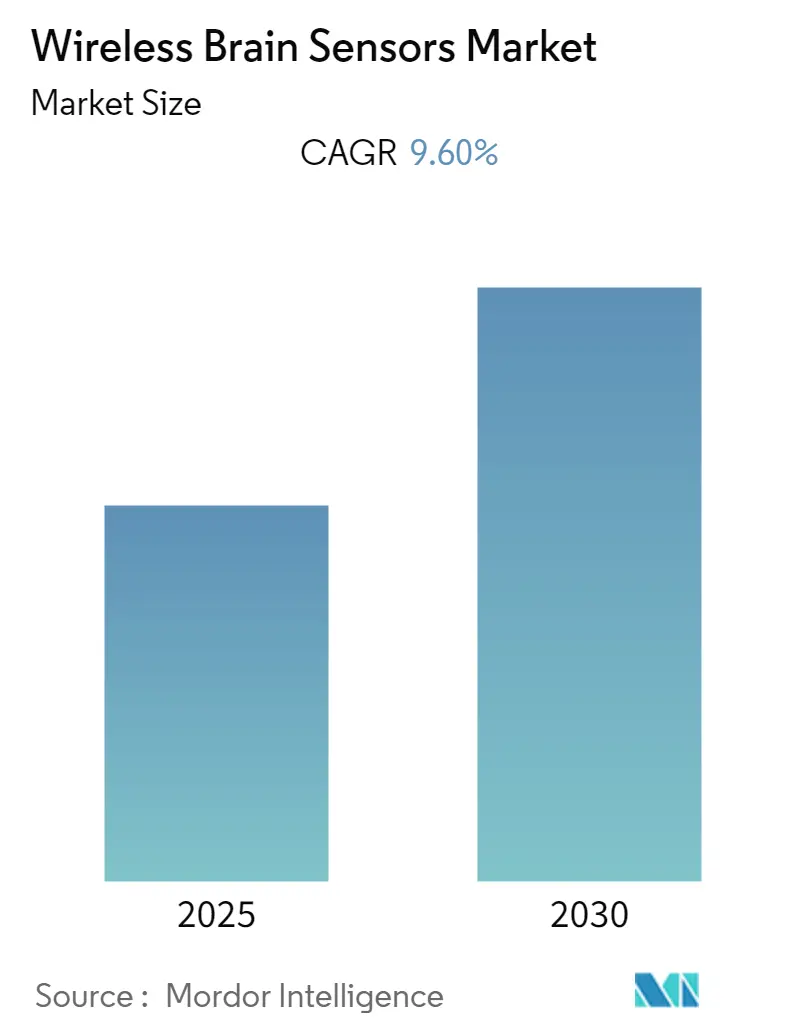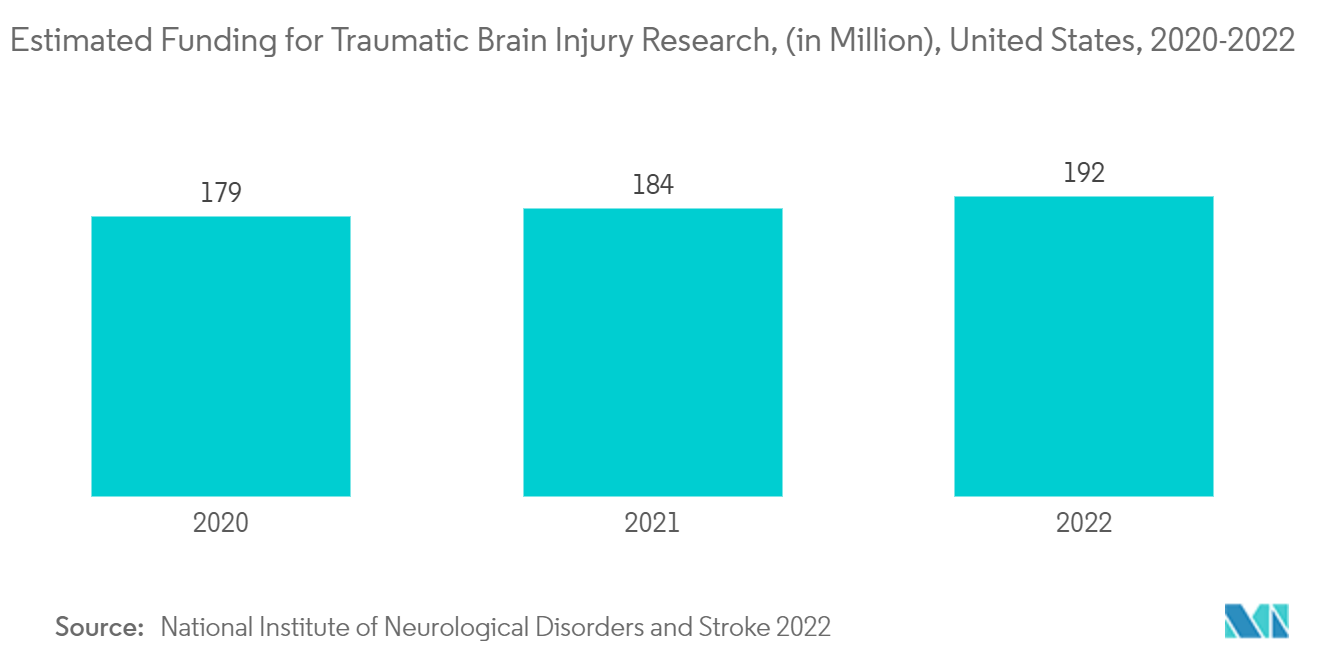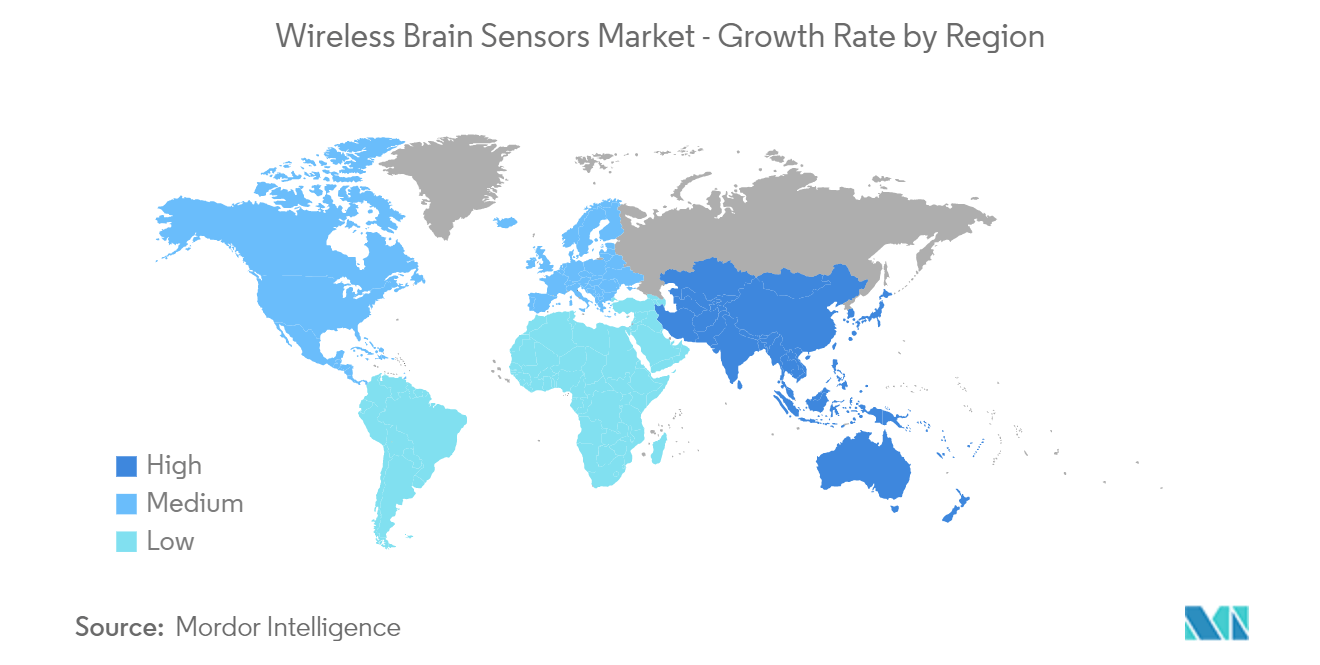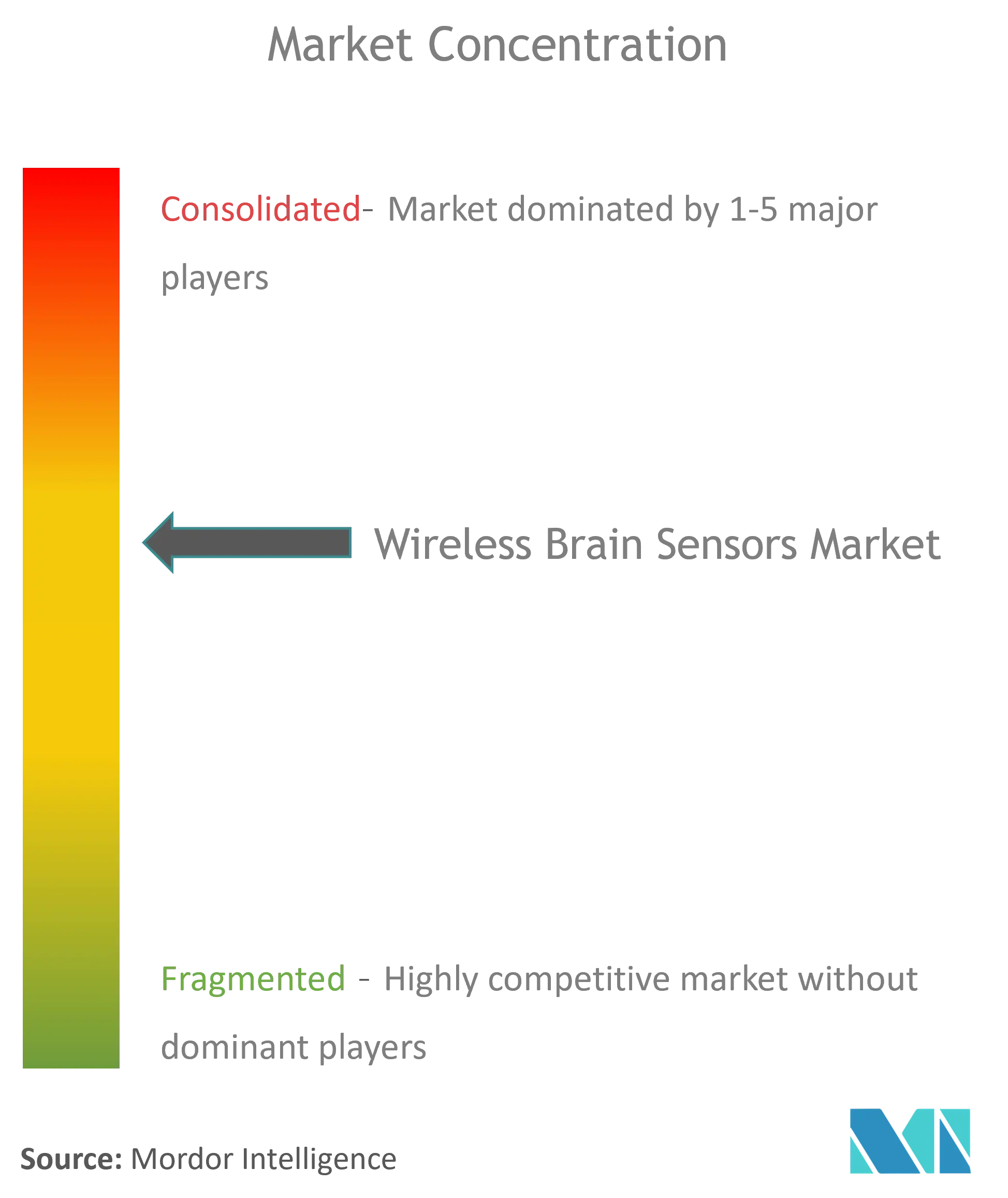Wireless Brain Sensors Market Analysis
The Wireless Brain Sensors Market is expected to register a CAGR of 9.6% during the forecast period.
The COVID-19 pandemic significantly impacted the wireless brain sensors market during its early phase, as many individuals had sleep difficulties and related brain problems. However, the market has been recovering since restrictions were lifted. The prevalence of neurological disorders, new product launches, and increasing demand for brain sensors have led the market over the last two years.
The primary factor contributing to the market's growth is the rising prevalence of neurological disorders such as Parkinson's disease, epilepsy, and Alzheimer's disease. Numerous factors, such as lifestyle changes and severe social environment variations, have collectively strengthened the demand for wireless brain sensors. For instance, as per an Alzheimer's Association report, an estimated 6.5 million Americans aged 65 and above are living with Alzheimer's. Of that population, 73% are aged 75 or above. According to the same source, the prevalence of Alzheimer's disease is increasing due to the growing geriatric population. By 2050, the number of people aged 65 and older with Alzheimer's is projected to increase to 12.7 million, barring medical breakthroughs to prevent, slow, or cure Alzheimer's disease. Hence, people may adopt wireless brain sensors to improve their quality of life, thereby boosting the market's growth.
There are over 10 million new cases of dementia each year worldwide, implying one new case every 3.2 seconds. Furthermore, the rising investments in research and development and technological advancements boost the market's growth. For instance, in January 2022, iMediSync, an AI-driven early detection and therapeutic platform for optimal brain health from Seoul, South Korea, showcased its comprehensive EEG solution (hardware + software + remote telehealth solution) to perform brain mental health screening and predictive analysis of potential mental conditions in just 10 minutes. It launched its first therapeutic device at the 2022 CES Las Vegas, iSyncWave, which integrates both EEG brain mapping and LED therapy.
Hence, owing to the above-mentioned factors, the wireless brain sensors market is likely to grow over the forecast period. However, stringent regulations and the complexity of the functionality of the product are likely to restrain the growth of the market studied.
Wireless Brain Sensors Market Trends
Traumatic Brain Injuries is Anticipated to Create Maximum Demand for Wireless Brain Sensors During the Forecast Period
Traumatic brain injury often occurs as a result of a severe sports injury or car accident. It can also result from a violent blow or jolt to the head or body. The dominant share of the traumatic brain injury segment is due to the rising incidence rates of traumatic brain injuries (TBI) and increased awareness programs and initiatives associated with TBI globally. For instance, World Head Injury Awareness Day is observed on March 20th annually to create awareness about head injuries and strategies to prevent accidents and brain injuries. The theme for the 2021-2023 campaign for world head injury awareness day is "More Than My Brain Injury." The day promotes the correct usage of safety gadgets such as helmets and seat belts through various events, which can prevent damage to the head when an accident occurs.
Furthermore, the support and research initiatives associated with TBI are a major reason for the market's growth. For instance, as per the 2022 update from the National Institute of Diabetes and Digestive and Kidney, the TBI program at the National Institute of Neurological Disorders and Stroke (NINDS) provides support and funds to extramural researchers studying basic, clinical and translational TBI research. NINDS-funded research includes studies to understand the mechanisms of TBI and its sequelae, preclinical and clinical studies for diagnosis, prognosis, potential therapeutics, and other aspects of TBI. The estimated funding for TBI in 2022 is USD 192 million.
Hence, owing to the above-mentioned factors, the traumatic brain injury segment is anticipated to witness growth over the forecast period.
North America is Expected to Witness a Growth in the Wireless Brain Sensors Market During the Forecast Period
North America is expected to dominate the overall wireless brain sensors market throughout the forecast period due to factors such as the increasing number of neurological diseases and advancements in the research field of wireless brain sensors. For instance, as per a Brain Tumor Society 2022 update, an estimated 700,000 people in the United States are living with a primary brain tumor, and approximately 88,970 more are likely to be diagnosed in 2022. Furthermore, as per the Alzheimer's Association 2022 report, more than 6 million Americans are living with Alzheimer's. By 2050, this number is projected to rise up to 13 million. As per the same source, in 2022, Alzheimer's and other dementias are likely to cost the nation USD 321 billion. By 2050, these costs are anticipated to reach nearly USD 1 trillion.
Moreover, sleep disorders are also one of the main factors boosting the market's growth, as sleep monitoring devices are utilized during the treatment of the disorder to assess the progress of the patient. There are a lot of studies conducted depicting sleep disorder issues in the region. For instance, as per an article published by JNS, due to the lack of sleep and a sedentary lifestyle, people in Mexico suffer from sleep disorders. Owing to the high prevalence of neurological disorders in the region, the market studied is anticipated to witness growth.
Moreover, increasing approvals from the US FDA and product launches by key players are expected to boost the market's growth as these approvals and products are likely to increase the chance of the utilization of wireless brain sensors. For instance, in November 2021, Brain Scientific received the United States Food and Drug Administration clearance for its Next-Gen NeuroCap EEG Headset, an advanced electroencephalogram (EEG) electrode array used to obtain rapid EEGs in routine clinical and research settings where the recording of STAT EEGs is desired.
Owing to the above-mentioned factors, the market studied is likely to witness growth in North America during the forecast period.
Wireless Brain Sensors Industry Overview
The wireless brain sensors market is moderately competitive. A few of the crucial approaches followed by players functioning in the market include product advancements, inventions, acquisitions, and mergers. Some of the companies which are currently dominating the market are NeuroSky, EMOTIV, Advanced Brain Monitoring Inc., Koninklijke Philips NV, Medtronic, Muse, Natus Medical Incorporated, Cadwell Industries Inc., NeuroWave Systems Inc., and BrainScope.
Wireless Brain Sensors Market Leaders
-
NeuroSky
-
EMOTIV
-
Advanced Brain Monitoring, Inc.
-
Koninklijke Philips N.V.
-
Medtronic
- *Disclaimer: Major Players sorted in no particular order
Wireless Brain Sensors Market News
- September 2022: Amazon launched its first dedicated sleep device. The novel sleep monitor minimizes the need to wear a device while sleeping. Halo Rise is a bedside device that employs sensors, essentially a form of radar, to detect how well and how long a person sleeps. It also features a digital clock so that it can operate as a full-fledged bedside clock.
- September 2022: Sleepme Inc. launched the first-of-its-kind technology, Hiber-AI, along with a non-wearable sleep tracker that collects, analyzes, and acts on sleep data in real time. Both products are part of the new sleepme+ membership. When the sleep tracker is paired with the award-winning Dock Pro Sleep System, Hiber-AI will adjust the bed temperature based on a person's current real-time sleep data.
Wireless Brain Sensors Industry Segmentation
Wireless brain sensors are devices that help to observe the temperature, sense intracranial pressure, and record brain signaling in the form of brain waves. The essential aim of this wireless brain sensor is to secure the person from emergency situations. The devices are mainly used for patients suffering from sleep disorders, traumatic brain injury, dementia, Parkinson's disease, and other neurological conditions.
The wireless brain sensors market is segmented by product type (devices and accessories), application (traumatic brain injuries, dementia, sleep disorders, and other applications), and geography (North America, Europe, Asia-Pacific, South America, and Middle East and Africa). The report also covers the estimated market sizes and trends for 17 countries across major regions globally. The report offers values in USD million for all the above-mentioned segments.
| By Product Type | Devices | Electroencephalography Devices | |
| Sleep Monitoring Devices | |||
| Other Devices | |||
| Accessories | |||
| By Application | Traumatic Brain Injuries | ||
| Dementia | |||
| Sleep Disorders | |||
| Other Applications | |||
| By Geography | North America | United States | |
| Canada | |||
| Mexico | |||
| Europe | Germany | ||
| United Kingdom | |||
| France | |||
| Italy | |||
| Spain | |||
| Rest of Europe | |||
| Asia-Pacific | China | ||
| Japan | |||
| India | |||
| Australia | |||
| South Korea | |||
| Rest of Asia-Pacific | |||
| Middle East and Africa | GCC | ||
| South Africa | |||
| Rest of Middle East and Africa | |||
| South America | Brazil | ||
| Argentina | |||
| Rest of South America | |||
Wireless Brain Sensors Market Research FAQs
What is the current Wireless Brain Sensors Market size?
The Wireless Brain Sensors Market is projected to register a CAGR of 9.6% during the forecast period (2025-2030)
Who are the key players in Wireless Brain Sensors Market?
NeuroSky, EMOTIV, Advanced Brain Monitoring, Inc., Koninklijke Philips N.V. and Medtronic are the major companies operating in the Wireless Brain Sensors Market.
Which is the fastest growing region in Wireless Brain Sensors Market?
Asia-Pacific is estimated to grow at the highest CAGR over the forecast period (2025-2030).
Which region has the biggest share in Wireless Brain Sensors Market?
In 2025, the North America accounts for the largest market share in Wireless Brain Sensors Market.
What years does this Wireless Brain Sensors Market cover?
The report covers the Wireless Brain Sensors Market historical market size for years: 2019, 2020, 2021, 2022, 2023 and 2024. The report also forecasts the Wireless Brain Sensors Market size for years: 2025, 2026, 2027, 2028, 2029 and 2030.
Our Best Selling Reports
Wireless Brain Sensors Industry Report
Statistics for the 2025 Wireless Brain Sensors market share, size and revenue growth rate, created by Mordor Intelligence™ Industry Reports. Wireless Brain Sensors analysis includes a market forecast outlook for 2025 to 2030 and historical overview. Get a sample of this industry analysis as a free report PDF download.

